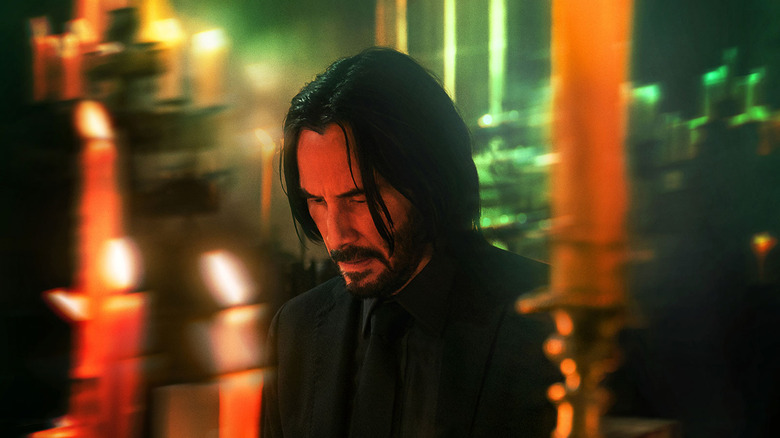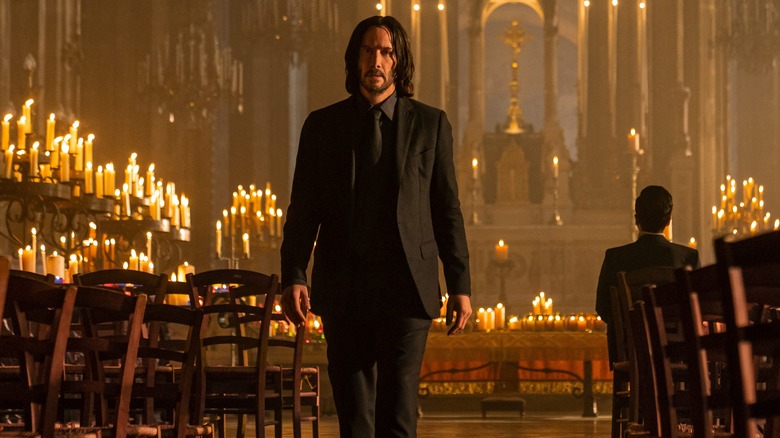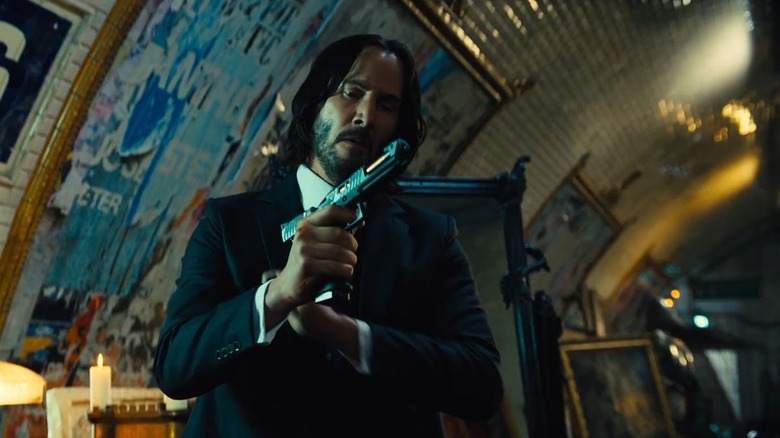John Wick: Chapter 4 Review: Keanu Reeves' New Greatest Tetralogy
- The biggest and best "John Wick" sequel yet
- This is the action epic you've always dreamed about
- I could have watched another hour of this -- 169 minutes just wasn't long enough
When hearing a director describe their movie as a love letter to cinema, it's easy to roll your eyes, imagining the cliched image of a young child gazing up at the big screen in amazement for the first time with the light from the projector reflecting down on their face. Nobody could accuse the "John Wick" franchise of resembling this Oscar-friendly format in any way, and yet this fourth chapter in the ongoing saga of Keanu Reeves' enduringly popular hitman feels like the purest example of what a cinematic love letter should constitute.
Much like Quentin Tarantino, you get the sense that the star and his regular collaborator Chad Stahelski (his former stuntman-turned-director) are motivated to make movies entirely through how they can show affection to the ones they've loved throughout the years, folding direct tributes to classics from a variety of genres into a single, thrillingly unpredictable beast. The influence of Eastern action movies on the franchise has long been apparent, but "Chapter 4" nods breathlessly to everything from the epic visual sweep of David Lean's "Lawrence of Arabia" to a third act that — much like Tarantino's own "Death Proof" — takes a healthy handful of cues from the 1970s B-movie "Vanishing Point." It's the sort of bombastic blockbuster every director at a certain level of studio filmmaking hopes they can make: It's the modern epic that lets them show off everything they love about movies, whilst twisting those influences into something completely distinctive that could have only been made by them.
Back to basics, but on a bigger scale than ever
With its penchant for spectacularly choreographed fights and elaborate kill scenes, the "Wick" franchise is the rare one to benefit from an ever-increasing budget, even if the previous entry did leave me with some cause for concern that its titular character's vengeance mission had finally run out of steam. Yes, it had some of the most inventive kills to date (and, admittedly, nothing here tops the ingeniousness of killing a man with a hardback book), but it was also far more burdened by the expanded lore of its criminal underworld than ever before. This did little to hide how unsatisfying it felt when it effectively ended in the same place as "Chapter 2," with Wick once again banished and the bounty on his head increasing by the second. Almost immediately in "Chapter 4," the momentum in his quest for vengeance is back, and it feels like there's an unspoken acknowledgment from Stahelski that we need to end on a high. We know Wick will return in the upcoming spin-off "Ballerina," but his central revenge mission needs to come to a close before audiences become too fatigued to want to explore the rest of this ever-expanding universe.
Not a single second is wasted from the opening frame, which is as pure a statement of intent as any in this franchise: an extreme close-up of Reeves' fists as he trains for the next big fight against the High Table. If the prior film was bogged down by too much exposition, here we immediately hit the ground running with the main reason why we've all come to watch a "John Wick" movie in the first place. Don't be put off by the film's epic runtime, as the lore underpinning this universe's various criminal organizations isn't expanded upon too much beyond what we already know; instead, Wick quickly realizes that killing its members won't make him a free man, leaving him scrambling to find a safe corner of the world. Meanwhile, High Table member Marquis de Gramont (franchise newcomer Bill Skarsgård) is making it known that no former associate of Wick will go unpunished whilst he's still alive, giving New York Continental owner Winston (Ian McShane) an ultimatum to help take him down, blowing his beloved hotel to smithereens in the process.
With the stakes (re-)established, the plot remains thrillingly simplistic, acting purely as an excuse to send Reeves' protagonist around the world and encounter assassins trained in different regionally specific forms of martial arts. Even in the first film, the "John Wick" series was never particularly grounded, and the lack of rules underpinning this universe is once again exploited to thrilling effect. Action set pieces are as hilariously improbable as they are irresistible, with the world of these films still operating on something akin to video game logic, where outside of the central fighters, the bemused wider world continues as normal around the drama. Fist fights can happen in the middle of the road next to the Arc de Triomphe and nobody bats an eyelid, largely because there doesn't appear to be any such thing as a regular civilian in this hitman-heavy society.
A video game come to life
That video game comparison isn't a flippant one either, as Stahelski and his team of fight choreographers seem to have taken as much inspiration from classic arcade games in the simple staging of many bruising sequences. Look no further than that third act — a high point for the franchise to date — which directly channels everything from "Frogger" in that aforementioned Parisian traffic sequence to "Donkey Kong" in a climactic sequence in which Wick must climb to the top of a set of stairs, facing off against a seemingly infinite number of hit men acting as obstacles along the way. Yes, the staging of these set pieces is bigger and better than before — I mean, just imagine the logistical difficulties of choreographing and shooting a fight scene right in the traffic-congested heart of Paris — but they're also the most straightforward in concept, trying to recapture the simple thrills of the earliest games, and translate those pleasures to a different medium. Heck, Bill Skarsgård's crime boss even figures into the plot as a final boss of sorts, with various new characters all seeming like they could have been taken directly out of a "Mortal Kombat" game, from blind swordsmen (the forever terrific Donnie Yen) to a hotel receptionist-turned-assassin (Rina Sawayama, who, in her film acting debut, proves to be a brilliant action star) and a German heavy at least twice the size of all those around him (Scott Adkins).
The fight sequences that these larger-than-life characters find themselves in defy all logic, even if Stahelski and company make sure you feel the impact of every punch — the film contains some of the harshest beatings its protagonist has suffered in the series so far. And yet, those injuries remain the only thing tying the "Wick" series to realism, with the team understanding that these movies now operate best on their own demented philosophies. If you try to pick apart a detail such as why, for example, Yen's assassin Caine can play a game of cards and know what's on every hand despite being blind, then you will never be able to get on the delightfully ridiculous wavelength that this movie requires.
Each film in the franchise has pivoted further and further from the original, comparatively grounded noir throwback released back in 2014, and the saga has become all the better for it. This is the culmination of its creators' various movie obsessions, successfully managing to carve out something cohesive from a grab bag of influences that run from westerns to martial arts classics. There are no rules in the "Wick" universe, where violence can emerge from any direction and any unassuming figure can be a fearsome killer, and this epic-length latest entry takes advantage of that lack of rules like never before. It's a love letter to decades of genre cinema from all over the globe, masquerading as a straightforward franchise entry.
"John Wick: Chapter 4" hits theaters on Friday, March 24.


